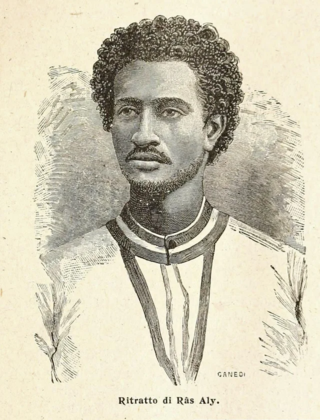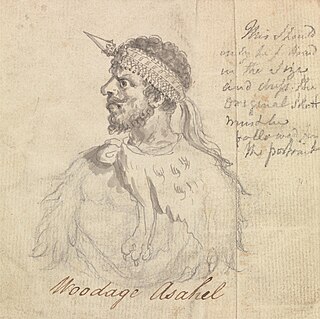Related Research Articles

Tewodros II was Emperor of Ethiopia from 1855 until his death in 1868. His rule is often placed as the beginning of modern Ethiopia and brought an end to the decentralized Zemene Mesafint.
Yohannes III was Emperor of Ethiopia intermittently between 1840 and 1851, and a member of Solomonic dynasty. He was the son of Tekle Giyorgis. He was largely a figurehead, with real power in the hands of the Enderase or Regent, Ras Ali II a princeling of the Yejju Dynasty. Ras Ali's mother was the Empress Menen Liben Amede.
Sahle Dengel was Emperor of Ethiopia intermittently between 1832 and 11 February 1855, towards the end of the Zemene Mesafint. He was largely a figurehead, with real power in the hands of Ras Ali II of Yejju.
Marye of Yejju was a Ras of Begemder and Enderase (regent) of the Emperor of Ethiopia. He was the brother of his predecessor Ras Yimam.
Yimam of Yejju was a Ras of Begemder and Enderase (regent) of the Emperor of Ethiopia. He was the son of Gugsa of Yejju.

Ali II of Yejju was Ras of Begemder and the de facto ruler of the Ethiopian Empire. He was a member of a powerful Oromo dynasty known as the Yejju, which ruled much of the Ethiopian Empire during the Zemene Mesafint.
The Battle of Debre Tabor was a conflict during the Zemene Mesafint in 1842 initiated by Dejazmach Wube Haile Maryam to overthrow Ras Ali II as Regent of the Emperor of Ethiopia and gain control of Ethiopia. This confused battle was won by Ras Ali, but at a steep price, and this victory failed to cement his position as the most powerful nobleman of his time.
The Battle of Amba Jebelli was fought in Ethiopia in 1854 between the forces of Kassa Hailu, and the forces of Birru Goshu of Gojjam. Kassa was victorious, Birru Goshu was captured and spent the next 14 years in chains.
The Battle of Ayshal was fought on 29 June 1853, between the forces of Kassa Hailu and the forces of Ras Ali II, in Ayshal, in eastern Gojjam. Kassa's forces won the battle.

The Zemene Mesafint was a period in Ethiopian history between the mid-18th and mid-19th centuries when the country was ruled by a class of Oromo elite noblemen who replaced Habesha nobility in their courts, making the emperor merely a figurehead. For the most part, the regional lords were tightly related by marriage and constituted a stable ruling elite that prevailed until the mid-20th century. In short, during the Zemene Mesafint, the emperors from the Solomonic dynasty were reduced to little more than figureheads confined to the capital city of Gondar.
Dengel Ber is a town in western Ethiopia. Located on the south-western shore of Lake Tana in the Semien Gondar Zone of the Amhara Region, this town has a latitude and longitude of 11°57′N37°00′E. Access to this town includes track roads to both Shawra and Kunzela and weekly service by the Bahir Dar-Gorgora ferry on Lake Tana. While the name of the town is indisputably Amharic, there is some disagreement over the meaning of its name: while "Pass of the Virgin" has been the most common interpretation since at least the days James Bruce visited Ethiopia, Huntingford and Beckingham state that it means "pass of canna plants".

Tekle Haymanot Tesema, also known as Adal Tesema, Tekle Haymanot of Gojjam, and Tekle Haimanot of Gojjam, was King of Gojjam. He was later an army commander and a member of the nobility of the Ethiopian Empire.

The Yejju Oromo, also historically known as the Yajju, Edjow or Edjou Galla, are a sub-clan of the Barento branch of Oromo people. They are one of the northernmost communities of Oromo people residing in Ethiopia, along with the Raayyaa.
Dejazmach Birru Aligaz was a nobleman of 19th century Ethiopia during the Zemene Mesafint. As Dejazmach, he held the governorships of different districts such as Lasta and Dembiya and was made governor of Dawunt, Wollo in 1842 by Ras Ali II of Yejju. He was the son of Ras Aligaz Abba Seru Gwangul, and had a son called Dejazmach Zegeye.

Wube Haile Maryam of Semien,, also called by his title Dejazmach Wube, Webé; his name is also given in European sources as ‘‘Ubie’’, was one of the major figures of 19th century Ethiopia, during the closing decades of the Zemene Mesafint a period of regional lords vying for power, prestige and territory amid a weakened authority of the emperors.
Menen Liben Amede was Empress consort of Ethiopia by marriage to Emperor Yohannes III in 1840–1841, 1845 and 1850–1851.
Betul Haile Maryam was a member of the Semien nobility through his paternal line in the Ethiopian Empire.

This article is about the history of Gondar, a city in Amhara Region of Ethiopia, and previously served as the capital of the Ethiopian Empire from 1632 (at the beginning of Gondarine period to 1855 era.
Goshu Zewde of Gojjam, also known by his horse name Abba Kanno, was a prominent governor of Damot, Metcha, and Ybaba during the first half of the 19th century. While his son Birru Goshu governed most of Gojjam, Goshu’s influence extended widely, solidifying his reputation as a formidable leader. As a member of the ruling dynasty of Gojjam, he was one of the significant lords in the last decades of the Zemene Mesafint. Respected by princes, church leaders, and farmers alike, Goshu was admired for his noble lineage and his admirable character. His influence and dedication were further recognized when he was granted the title of Dejazmach in 1825 and elevated to Ras by Emperor Sahle Dengel in 1848.
Dejazmach Birru Goshu (1814-1869) of Gojjam was a significant Ethiopian noble who held considerable sway over the political landscape of Ethiopia during the latter period of the Zemene Mesafint, a time of intense regional competition among ruling dynasties. According to the British diplomat Walter Plowden, Birru Goshu was "the most remarkable man in Abyssinia" before the rise of Tewodros II.
References
- ↑ Henze, Paul B (2000). Layers of Time : A History of Ethiopia. C. Hurst & Co. Publishers. p. 135. ISBN 9781850653936.
- 1 2 3 Sven Rubenson, King of Kings: Tewodros of Ethiopia (Addis Ababa: Haile Selassie I University, 1966), pp. 41f